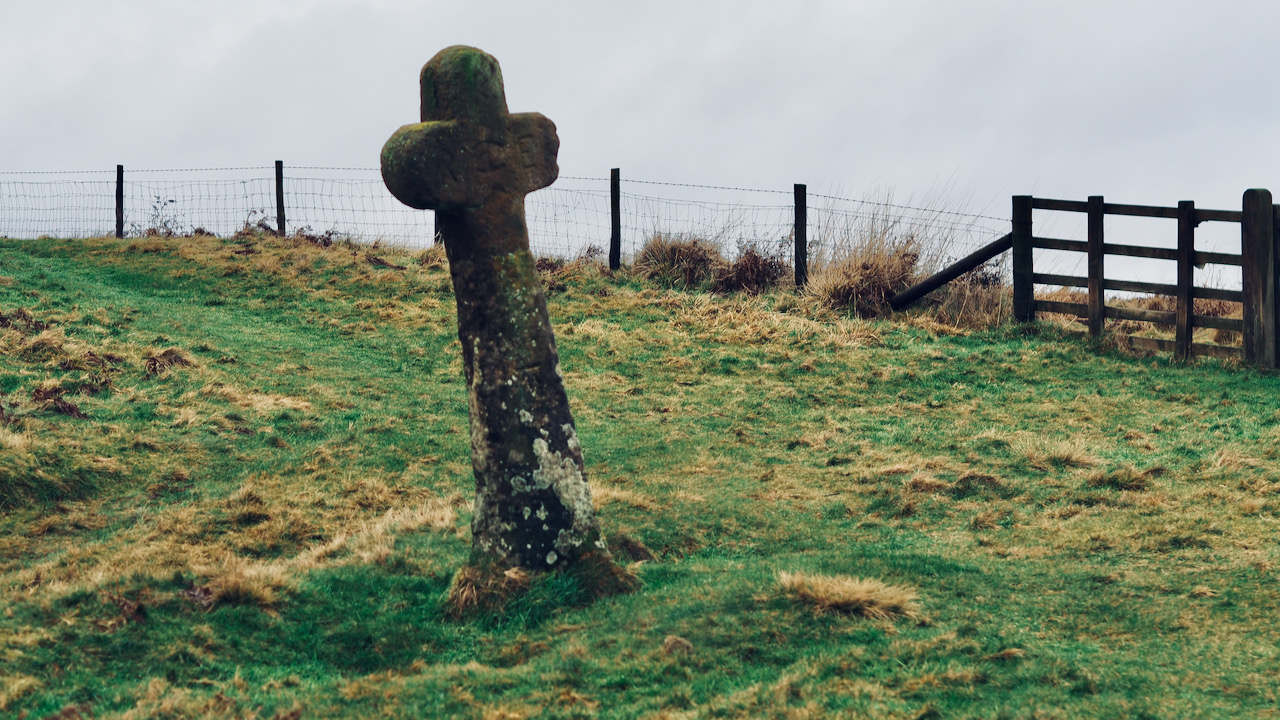Behold, another photo from yesterday’s saunter around Saltergate.
Malo Cross, an imposing structure, proper cross, if you will. According to Historic England, it was erected by Sir Richard Egerton in 1619, serving as a boundary marker for his manor of Allerston1‘Malo Cross, 450m South East of Nab Farm, Allerston – 1021168 | Historic England’. 2024. Historicengland.org.uk <https://historicengland.org.uk/listing/the-list/list-entry/1021168?section=official-list-entry> [accessed 22 January 2024]2NYMNP HER No: 6060..
The upper part, the actual cruciform segment, appears to have undergone some repair. This likely occurred during the period when the headstone disappeared for 50 years or so, only to resurface in a Pickering garden in the 1920s3‘ANCIENT CROSSES IN THE NORTH RIDING | Yorkshire Post and Leeds Intelligencer | Saturday 17 May 1924 | British Newspaper Archive’. 2024. Britishnewspaperarchive.co.uk <https://www.britishnewspaperarchive.co.uk/viewer/bl/0000687/19240517/382/0014> [accessed 22 January 2024].
There’s a yarn making the rounds, a tale of Egerton expanding his land into the Royal Forest and erecting the boundary stone adorned with his initials. This audacious move led to charges of trespass and encroachment, with Egerton being found guilty of ‘divers enclosures.’4Beadle, Brian. 2008. ‘Take the Old Wive’s Way to Get Cross’, Gazette & Herald (Gazette & Herald) <https://www.gazetteherald.co.uk/news/3578565.take-the-old-wives-way-to-get-cross/> [accessed 22 January 2024]
Back in the 13th century, these royal forests were the King’s personal hunting playgrounds, even if he didn’t actually own every square inch. They were governed by the lofty principles of ‘Forest Law.’ But by the Tudor era, Forest Law had become a bit of a relic, mainly functioning as a guardian of timber in those royal woods. Moreover, Egerton’s Allerston manor nestled comfortably within the Royal Forest of Pickering. So, as they say, the plot thickens, and the historical narrative doesn’t exactly stack up.
Now, the name ‘Malo’ has its own curious backstory. It is generally thought that ‘Malo-Lacu’ was a moniker pinned to Peter de Mauley5‘Maulay [Malo Lacu], Peter de (D. 1241), Knight and Royal Councillor’. 2024. Oxford Dictionary of National Biography <https://www.oxforddnb.com/display/10.1093/ref:odnb/9780198614128.001.0001/odnb-9780198614128-e-18375> [accessed 22 January 2024]. ‘Malo-Lacu’ translates to the ‘Evil Lake’ or, more colloquially, ‘Ass-Pain.’6Hudson, Martyn. “on blackamoor”. Page 59. 2020. ISBN 978-1-9164257-9-8 This Mauley character secured Mulgrave Castle through matrimony, and a macabre wedding gift for having offed Prince Arthur in 1203, the lad being the son of King John’s elder brother and a potential obstacle to Mauley’s path to the throne7‘Mulgrave Castle’, Wikipedia (Wikimedia Foundation) <https://en.wikipedia.org/wiki/Mulgrave_Castle#:~:text=De%20Mauley%20was%20a%20native%20of%20Poitou%2C%20whose%20marriage%20to%20this%20wealthy%20heiress%20is%20said%20to%20have%20been%20his%20reward%20for%20having%20murdered%20in%201203%20Prince%20Arthur%2C%20the%20son%20of%20John%27s%20elder%20brother%20who%20threatened%20his%20succession%20to%20the%20throne.> [accessed 22 January 2024].
Malo Cross stands as a silent sentinel, its weathered form whispering tales of land-grabbing knights and cryptic monikers. Beneath its shadow, buried truths may yet await.
- 1‘Malo Cross, 450m South East of Nab Farm, Allerston – 1021168 | Historic England’. 2024. Historicengland.org.uk <https://historicengland.org.uk/listing/the-list/list-entry/1021168?section=official-list-entry> [accessed 22 January 2024]
- 2NYMNP HER No: 6060.
- 3‘ANCIENT CROSSES IN THE NORTH RIDING | Yorkshire Post and Leeds Intelligencer | Saturday 17 May 1924 | British Newspaper Archive’. 2024. Britishnewspaperarchive.co.uk <https://www.britishnewspaperarchive.co.uk/viewer/bl/0000687/19240517/382/0014> [accessed 22 January 2024]
- 4Beadle, Brian. 2008. ‘Take the Old Wive’s Way to Get Cross’, Gazette & Herald (Gazette & Herald) <https://www.gazetteherald.co.uk/news/3578565.take-the-old-wives-way-to-get-cross/> [accessed 22 January 2024]
- 5‘Maulay [Malo Lacu], Peter de (D. 1241), Knight and Royal Councillor’. 2024. Oxford Dictionary of National Biography <https://www.oxforddnb.com/display/10.1093/ref:odnb/9780198614128.001.0001/odnb-9780198614128-e-18375> [accessed 22 January 2024]
- 6Hudson, Martyn. “on blackamoor”. Page 59. 2020. ISBN 978-1-9164257-9-8
- 7‘Mulgrave Castle’, Wikipedia (Wikimedia Foundation) <https://en.wikipedia.org/wiki/Mulgrave_Castle#:~:text=De%20Mauley%20was%20a%20native%20of%20Poitou%2C%20whose%20marriage%20to%20this%20wealthy%20heiress%20is%20said%20to%20have%20been%20his%20reward%20for%20having%20murdered%20in%201203%20Prince%20Arthur%2C%20the%20son%20of%20John%27s%20elder%20brother%20who%20threatened%20his%20succession%20to%20the%20throne.> [accessed 22 January 2024]

Leave a Reply